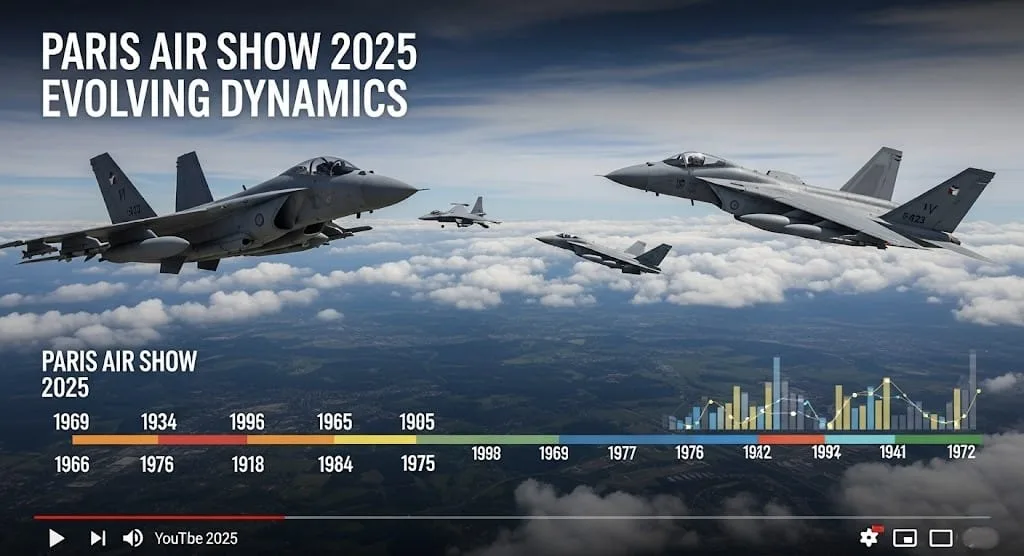The Paris Air Show 2025 at Le Bourget has concluded, and while the atmosphere was notably more subdued than in previous years, it delivered a clear message: the aviation industry continues its robust recovery, albeit with new priorities and a significantly altered competitive landscape. Total commercial aircraft transactions reached 601, a modest rebound from Farnborough 2024 but a sharp decline from Paris 2023’s bonanza of 1,338 commitments. This year, Airbus undeniably dominated the headlines with a significant number of major aircraft orders, while Boeing adopted a low profile, demonstrating a stark contrast in their show strategies.
The underlying drivers for orders remained consistent: the urgent need to replace aging, less fuel-efficient fleets, and the burgeoning demand for air travel, particularly from Asian carriers and low-cost airlines. However, persistent supply chain disruptions, notably concerning engine deliveries, and the somber shadow cast by the recent Air India Flight 171 tragedy, profoundly impacted the show’s mood and the pace of announcements.
Airbus’s Commanding Presence: A Symphony of Strategic Wins
Airbus, the European aerospace powerhouse, emerged as the clear leader in commercial orders, demonstrating impressive resilience and strategic prowess. The manufacturer secured a total of 250 firm orders and 156 options, translating to approximately $21 billion in deals.
- VietJet’s Landmark A321neo Deal: The highlight was a Memorandum of Understanding (MoU) with Vietnamese low-cost carrier VietJet Air for 100 A321neo aircraft, with potential for an additional 50. This single deal, valued at an estimated $6.3 billion, significantly bolstered Airbus’s narrowbody backlog and underscored VietJet’s aggressive growth in the Asia-Pacific region.
- Widebody Dominance Continued: Airbus solidified its lead in the widebody segment. STARLUX Airlines of Taiwan firmed up an order for 10 additional A350-1000s, while EGYPTAIR committed to six more A350-900s. These orders reflect the sustained demand for long-haul, fuel-efficient aircraft to support network expansion.
- Freighter Market Expansion: The new-generation A350F freighter gained further traction with an MoU from Turkish cargo carrier MNG Airlines for two aircraft. This signals the growing importance of dedicated cargo solutions driven by the e-commerce boom and the need for more efficient cargo operations.
- Strategic Regional Shifts: In a significant move, LOT Polish Airlines placed its first-ever Airbus order for 40 A220s (20 A220-100s and 20 A220-300s), with options for 44 more. This decision marks a strategic shift for LOT, which has historically been an Embraer customer, highlighting the A220’s increasing competitiveness in the regional market.
- Saudi Arabian Growth: Airbus also made significant inroads in Saudi Arabia, with Riyadh Air ordering 25 A350-1000s and leasing company AviLease securing 10 A350F freighters and 30 A320neos. These deals align with Saudi Arabia’s ambitious Vision 2030 to become a global aviation hub.
Airbus’s CEO, Christian Scherer, began each announcement with a moment of solemn remembrance for the victims of the Air India crash, setting a respectful tone that permeated their presentations.
Embraer’s Confident Niche: Regional Strength and Diversification
While not reaching Airbus’s staggering numbers, Embraer delivered a confident performance, reinforcing its leadership in the regional jet segment and making strategic moves into new markets.
- SkyWest’s E175 Reinforcement: Embraer’s most significant commercial order came from SkyWest Airlines, with a firm order for 60 E175 regional jets and options for an additional 50. This $3.6 billion deal solidifies SkyWest’s position as the world’s largest E175 operator and underscores the continued demand for 76-seat regional jets in the North American market, driven by existing scope clauses.
- Launch of the E-Freighter: Embraer officially launched its E190F passenger-to-freight (P2F) conversion program, naming Bridges Air Cargo as the launch customer for two E190Fs. This move positions Embraer to capitalize on the growing regional air cargo market.
- Military Transport Success: In the defense sector, Lithuania committed to acquiring three C-390 Millennium military transport aircraft, showcasing the C-390’s increasing appeal on the global stage.
- E2 Entry into Japan: ANA Holdings finalized an order for 15 E190-E2 aircraft with options for five more, marking the first E2 family jets for Japan, expanding Embraer’s presence in the crucial Asian market.
Embraer’s results highlight its agility and focus on diversified growth, adapting to evolving market needs.
Boeing’s Deliberate Silence: A Time for Reflection
In stark contrast to its competitors, Boeing maintained a profoundly subdued presence throughout the Paris Air Show. This strategic decision was a direct response to the tragic Air India Flight 171 crash involving a Boeing 787 Dreamliner just days before the show.
- Prioritizing Investigation: Boeing executives, including CEO Kelly Ortberg, cancelled their attendance, stating a need to focus on the ongoing investigation into the accident and to be with affected customers.
- Respectful Tone: Boeing’s booth featured a somber display, honoring the victims, reflecting a period of reflection rather than aggressive sales.
- Limited Commercial Announcements: Boeing announced only a handful of pre-show orders, most notably ANA Holdings’ 23 787-9 Dreamliners and 18 737 MAX 8s, but made no new commercial deals during the show itself. This marks its lowest order total at a Paris or Farnborough Air Show in over 12 years.
While Boeing’s quiet approach was understandable given the circumstances, it allowed Airbus to dominate the commercial narrative, creating a unique dynamic for this year’s show. Industry analysts noted that this was more about context than competition, with Boeing’s vast existing backlog still providing a strong foundation.
Key Highlights of Paris Air Show 2025
| Feature | Description |
| Airbus’s Market Dominance | Secured 250 firm and 156 optional orders, totaling ~$21 billion, led by VietJet’s 100+ A321neo deal. |
| Boeing’s Muted Strategy | Maintained a low profile with no major new commercial announcements, focusing on the Air India crash investigation. |
| Regional & Cargo Growth | Embraer bolstered its regional E175 orders (SkyWest) and launched its E-Freighter P2F conversion program. |
| Focus on Efficiency & Sustainability | Orders heavily favored fuel-efficient, new-generation aircraft, with continued strong interest in eVTOLs and SAF discussions. |
Looking Ahead: Navigating Challenges and Embracing Innovation
Beyond the order books, the Paris Air Show 2025 highlighted several ongoing trends and challenges. While supply chain issues, particularly for engines, persist, Airbus reported a 40% reduction in delivery delays in early 2025, signaling some easing. Discussions around Sustainable Aviation Fuel (SAF) and future propulsion technologies, including hydrogen power and eVTOLs, remained prominent, indicating a strong industry commitment to decarbonization. The rise of AI-powered “wingman” drones also showcased the rapid advancements in the defense sector, reflecting heightened geopolitical tensions.
Despite a more subdued atmosphere, the Paris Air Show 2025 reaffirmed the robust long-term demand for aircraft and the industry’s continuous drive for innovation and efficiency. The divergent strategies of Airbus and Boeing underscored the complexities and sensitivities of the current aerospace landscape, yet the underlying trajectory for growth remains firmly in place.
Frequently Asked Questions (FAQs)
Q1: Which manufacturer secured the most aircraft orders at the Paris Air Show 2025?
A1: Airbus secured the most commercial aircraft orders at the Paris Air Show 2025, with a total of 250 firm orders and 156 options, valued at approximately $21 billion.
Q2: Why did Boeing have such a quiet presence at this year’s air show?
A2: Boeing maintained a quiet and subdued presence primarily due to the tragic Air India Flight 171 crash involving one of its 787 Dreamliners just before the show. The company chose to prioritize the ongoing investigation and express condolences, rather than focusing on new commercial sales announcements.
Q3: What were some key trends driving aircraft orders at the Paris Air Show 2025?
A3: Key trends driving aircraft orders included the need to replace aging, less fuel-efficient fleets, the rapid growth in passenger demand (especially from Asian carriers and low-cost airlines), and a continued emphasis on sustainable aviation technologies like new-generation aircraft, SAF, and eVTOLs.














